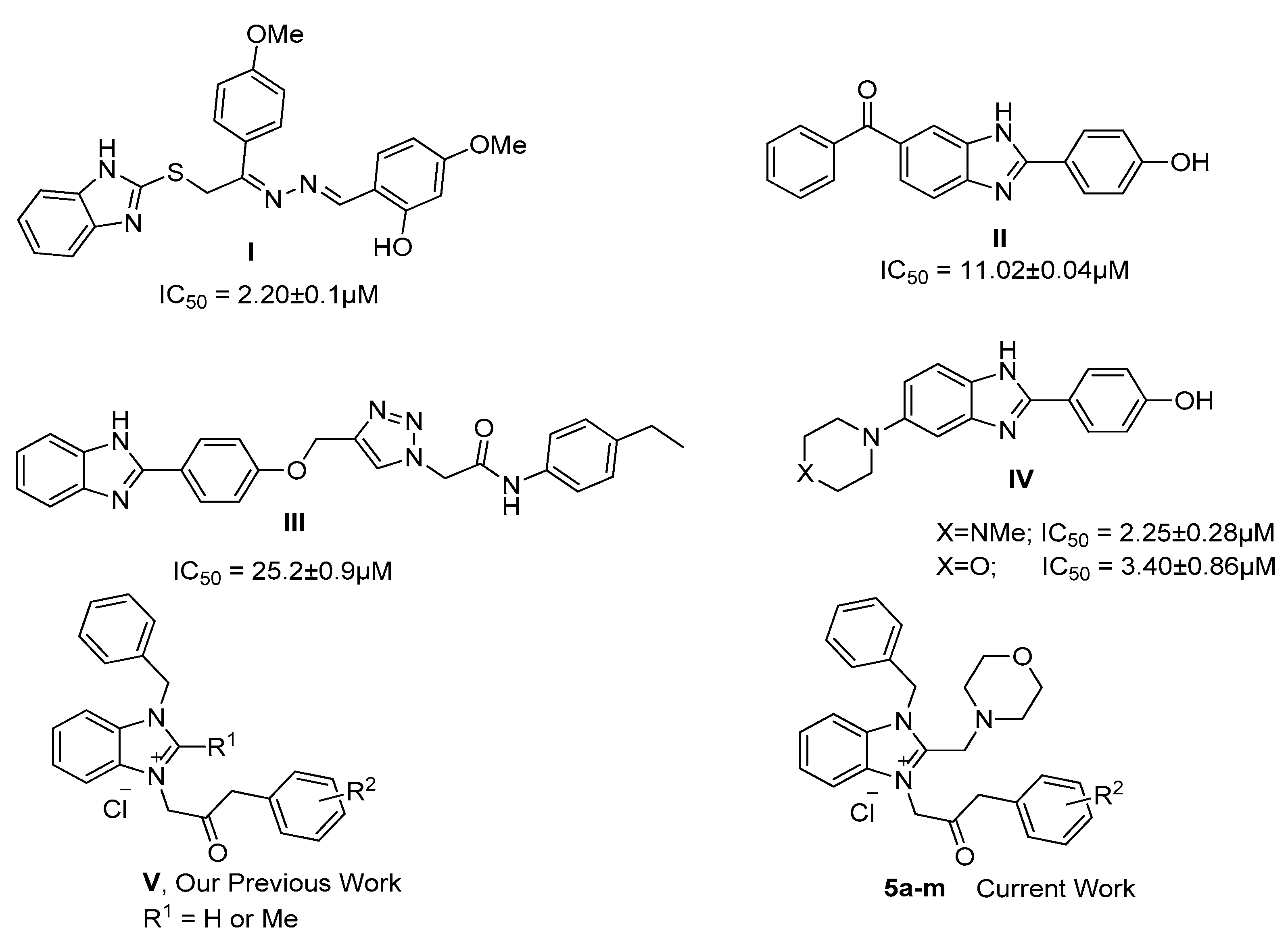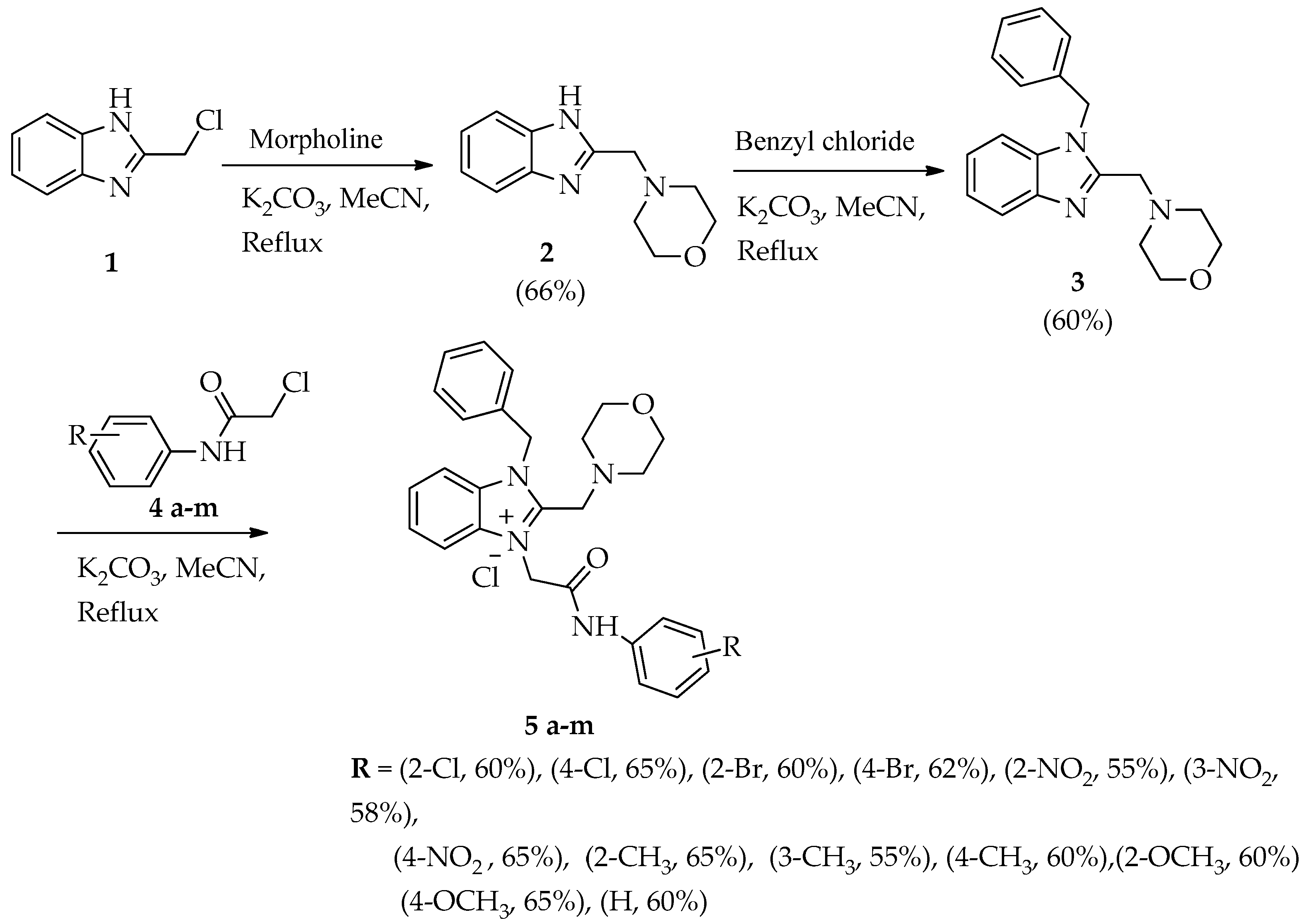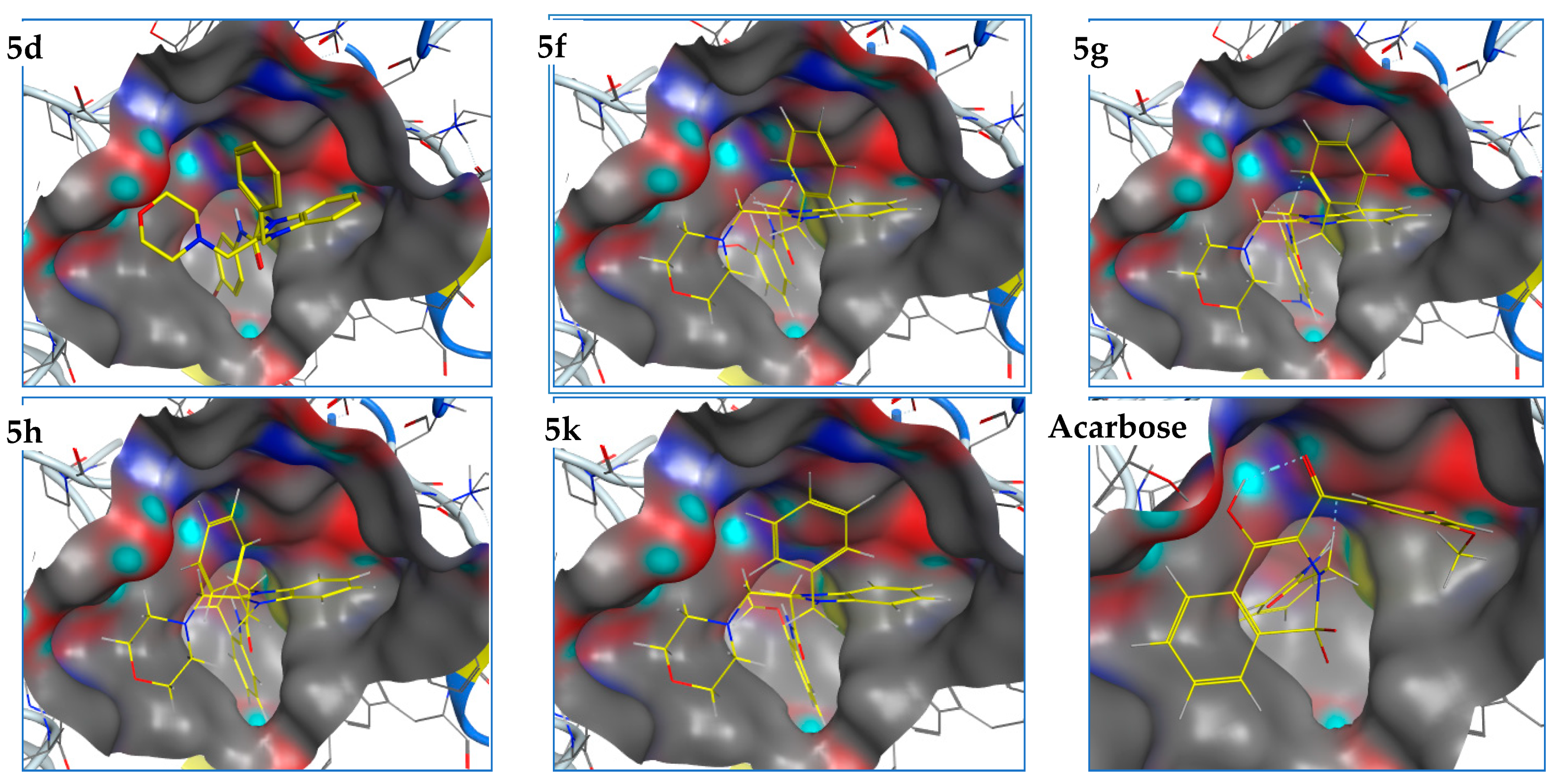Synthesis of Novel N-Methylmorpholine-Substituted Benzimidazolium Salts as Potential α-Glucosidase Inhibitors
Abstract
:1. Introduction
2. Results and Discussion
2.1. Chemistry
2.2. Characterization
2.3. In Silico α-Glucosidase Inhibition
2.4. In Vitro α-Glucosidase Inhibition
3. Materials and Methods
3.1. General
3.2. Synthesis of 4-((1H-benzimidazol-2-yl)methyl)morpholine (2)
3.3. Synthesis of 4-((1-benzyl-1H-benzimidazol-2-yl)methyl)morpholine (3)
3.4. General Procedure for the Preparation of Benzimidazolium Salts (5a–m)
3.5. Biological Evaluation
3.5.1. In Silico α-Glucosidase Inhibition Studies
3.5.2. In Vitro α-Glucosidase Inhibition Studies
4. Conclusions
Supplementary Materials
Author Contributions
Funding
Institutional Review Board Statement
Informed Consent Statement
Data Availability Statement
Acknowledgments
Conflicts of Interest
References
- Dej-Adisai, S.; Rais, I.R.; Wattanapiromsakul, C.; Pitakbut, T. Alpha-glucosidase inhibitory assay-screened isolation and molecular docking model from Bauhinia Pulla active compounds. Molecules 2021, 26, 5970. [Google Scholar] [CrossRef] [PubMed]
- Havale, S.H.; Pal, M. Medicinal chemistry approaches to the inhibition of dipeptidyl peptidase-4 for the treatment of type 2 diabetes. Bioorg. Med. Chem. 2009, 17, 1783–1802. [Google Scholar] [CrossRef] [PubMed]
- Du, X.; Wang, X.; Yan, X.; Yang, Y.; Li, Z.; Jiang, Z.; Ni, H. Hypoglycaemic effect of all-trans astaxanthin through inhibiting α-glucosidase. J. Funct. Foods 2009, 74, 104168. [Google Scholar] [CrossRef]
- Hossain, U.; Das, A.K.; Ghosh, S.; Sil, P.C. An overview on the role of bioactive α-glucosidase inhibitors in ameliorating diabetic complications. Food Chem. Toxicol. 2020, 145, 111738. [Google Scholar]
- Raha, O.; Chowdhury, S.; Dasgupta, S.; Raychaudhuri, P.; Sarkar, B.N.; Raju, P.V.; Rao, V.R. Approaches in type 1 diabetes research: A status report. Int. J. Diabetes Dev. Ctries 2009, 29, 85. [Google Scholar]
- Musa, A.; Ahmed, H.; Abuelwafa, N.; Abdullah, M.; Ahmed, A. Correlation between risk factors for diabetic peripheral neuropathy and nerve conduction study parameters in children with type 1 diabetes mellitus attending Sudan childhood diabetes centre. J. Neurol. Sci. 2019, 405, 48–49. [Google Scholar] [CrossRef]
- Watson, L.E.; Phillips, L.K.; Wu, T.; Bound, M.J.; Checklin, H.; Grivell, J.; Jones, K.L.; Hororwitz, M.; Rayner, C.K. Differentiating the effects of whey protein and guar gum preloads on postprandial glycemia in type 2 diabetes. Clin Nutr. 2019, 38, 2827–2832. [Google Scholar] [CrossRef]
- Esser, N.; Paquot, N.; Scheen, A.J. Anti-inflammatory agents to treat or prevent type 2 diabetes, metabolic syndrome and cardiovascular disease. Expert Opin. Inv. Drugs 2015, 24, 283–307. [Google Scholar] [CrossRef]
- Khan, H.; Lasker, S.S.; Chowdhury, T.A. Exploring reasons for very poor glycaemic control in patients with type 2 diabetes. Prim Care Diabetes 2011, 5, 251–255. [Google Scholar] [CrossRef]
- Arafa, A.; Dong, J.Y. Depression and risk of gestational diabetes: A meta-analysis of cohort studies. Diabetes Res. Clin. Pract. 2019, 156, 107826. [Google Scholar] [CrossRef]
- Wu, X.; Ding, H.; Hu, X.; Pan, J.; Liao, Y.; Gong, D.; Zhang, G. Exploring inhibitory mechanism of gallocatechin gallate on a-amylase and a-glucosidase relevant to postprandial hyperglycemia. J. Funct. Foods 2018, 48, 200–209. [Google Scholar] [CrossRef]
- Rahim, F.; Zaman, K.; Taha, M.; Ullah, H.; Ghufran, M.; Wadood, A.; Rehman, W.; Uddin, N.; Shah, S.A.; Sajid, M.; et al. Synthesis, in vitro alpha-glucosidase inhibitory potential of benzimidazole bearing bis-Schiff bases and their molecular docking study. Bioorg. Chem. 2020, 94, 103394. [Google Scholar] [CrossRef] [PubMed]
- Bansal, Y.; Kaur, M.; Bansal, G. Antimicrobial potential of benzimidazole derived molecules. Mini-Rev. Med. Chem. 2019, 19, 624–646. [Google Scholar] [CrossRef]
- Shinde, V.S.; Lawande, P.P.; Sontakke, V.A.; Khan, A. Synthesis of benzimidazole nucleosides and their anticancer activity. Carbohydr. Res. 2020, 498, 108178. [Google Scholar] [CrossRef] [PubMed]
- Maghraby, M.T.E.; Abou-Ghadir, O.M.; Abdel-Moty, S.G.; Ali, A.Y.; Salem, O.I. Novel class of benzimidazole-thiazole hybrids: The privileged scaffolds of potent anti-inflammatory activity with dual inhibition of cyclooxygenase and 15-lipoxygenase enzymes. Bioorg. Med. Chem. 2020, 28, 115403. [Google Scholar] [CrossRef]
- Devine, S.M.; Challis, M.P.; Kigotho, J.K.; Siddiqui, G.; De Paoli, A.; MacRaild, C.A.; Avery, V.M.; Creek, D.J.; Norton, R.S.; Scammells, P.J. Discovery and development of 2-aminobenzimidazoles as potent antimalarials. Eur. J. Med. Chem. 2021, 221, 113518. [Google Scholar]
- Flora, G.; Senthilkannan, K.; Rengarajan, R.; Saravanan, P. Antidiabetic (AD), stiffness and hardness studies of 2-[4-(Trifluoromethyl) phenyl]-1H-benzimidazole crystals-(TFMPHB) macro and nano crystal. Mater. Today Proc. 2020, 33, 4233–4236. [Google Scholar] [CrossRef]
- Srivastava, R.; Gupta, S.K.; Naaz, F.; Gupta, P.S.S.; Yadav, M.; Singh, V.K.; Singh, A.; Rana, M.K.; Gupta, S.K.; Schols, D.; et al. Alkylated benzimidazoles: Design, synthesis, docking, DFT analysis, ADMET property, molecular dynamics and activity against HIV and YFV. Comput. Biol. Chem. 2020, 89, 107400. [Google Scholar]
- Lafzi, F.; Kilic, D.; Yildiz, M.; Saracoglu, N. Design, synthesis, antimicrobial evaluation, and molecular docking of novel chiral urea/thiourea derivatives bearing indole, benzimidazole, and benzothiazole scaffolds. J. Mol. Struct. 2021, 1241, 130566. [Google Scholar] [CrossRef]
- Tantray, M.A.; Khan, I.; Hamid, H.; Alam, M.S.; Dhulap, A.; Kalam, A. Synthesis of benzimidazole-linked-1, 3, 4-oxadiazole carboxamides as GSK-3β inhibitors with in vivo antidepressant activity. Bioorg. Chem. 2018, 77, 393–401. [Google Scholar] [CrossRef]
- Celik, I.; Ayhan-Kilcigil, G.; Guven, B.; Kara, Z.; Onay-Besikci, A. In Vitro and in Silico Evaluation of Some New 1 H-Benzimidazoles Bearing Thiosemicarbazide and Triazole as Epidermal Growth Factor Receptor Tyrosine Kinase Inhibitor. Polycycl. Aromat. Compd. 2021. [Google Scholar] [CrossRef]
- Aroua, L.M.; Almuhaylan, H.R.; Alminderej, F.M.; Messaoudi, S.; Chigurupati, S.; Al-mahmoud, S.; Mohammed, H.A. A facile approach synthesis of benzoylaryl benzimidazole as potential α-amylase and α-glucosidase inhibitor with antioxidant activity. Bioorganic Chem. 2021, 114, 105073. [Google Scholar] [CrossRef]
- Asemanipoor, N.; Mohammadi-Khanaposhtani, M.; Moradi, S.; Vahidi, M.; Asadi, M.; Faramarzi, M.A.; Mahdavi, M.; Biglar, M.; Larijani, B.; Hamedifar, H.; et al. Synthesis and biological evaluation of new benzimidazole-1,2,3-triazole hybrids as potential α-glucosidase inhibitors. Bioorganic Chem. 2020, 95, 103482. [Google Scholar] [CrossRef] [PubMed]
- Özil, M.; Parlak, C.; Baltaş, N. A simple and efficient synthesis of benzimidazoles containing piperazine or morpholine skeleton at C-6 position as glucosidase inhibitors with antioxidant activity. Bioorganic Chem. 2018, 76, 468–477. [Google Scholar] [CrossRef] [PubMed]
- Turker, F.; Celepci, D.B.; Aktas, A.; Taslimi, P.; Gok, Y.; Aygun, M.; Gulcin, I. meta-Cyanobenzyl substituted benzimidazolium salts: Synthesis, characterization, crystal structure and carbonic anhydrase, α-glycosidase, butyrylcholinesterase, and acetylcholinesterase inhibitory properties. Arch. Pharm. 2018, 351, 1800029. [Google Scholar] [CrossRef] [PubMed]
- Sandeli, A.E.K.; Boulebd, H.; Khiri-Meribout, N.; Benzerka, S.; Bensouici, C.; Ozdemir, N.; Gurbuz, N.; Ozdemir, I. New benzimidazolium N-heterocyclic carbene precursors and their related Pd-NHC complex PEPPSI-type: Synthesis, structures, DFT calculations, biological activity, docking study, and catalytic application in the direct arylation. J. Mol. Struct. 2022, 1248, 131504. [Google Scholar]
- Karatas, M.O.; Uslu, H.; Alici, B.; Gokce, B.; Gencer, N.; Arslan, O.; Arslan, N.B.; Ozdemir, N. Functionalized imidazolium and benzimidazolium salts as paraoxonase 1 inhibitors: Synthesis, characterization and molecular docking studies. Bioorg. Med. Chem. 2016, 24, 1392–1401. [Google Scholar] [CrossRef]
- La Cognata, S.; Armentano, D.; Marchesi, N.; Grisoli, P.; Pascale, A.; Kieffer, M.; Taglietti, A.; Davis, A.P.; Amendola, V. A Benzimidazolium-Based Organic Cage with Antimicrobial Activity. Chemistry 2022, 4, 855–864. [Google Scholar] [CrossRef]
- Khan, I.A.; Ahmad, M.; Ashfaq, U.A.; Sultan, S.; Zaki, M.E. Discovery of Amide-Functionalized Benzimidazolium Salts as Potent α-Glucosidase Inhibitors. Molecules 2021, 26, 4760. [Google Scholar] [CrossRef]
- Lavecchia, A.; Giovanni, C.D. Virtual screening strategies in drug discovery: A critical review. Curr. Med. Chem. 2013, 20, 2839–2860. [Google Scholar]
- Ruyck, J.D.; Brysbaert, G.; Blossey, R.; Lensink, M.F. Molecular docking as a popular tool in drug design, an in silico travel. Adv. Appl. Bioinform. Chem. 2016, 6, 1–11. [Google Scholar] [CrossRef] [PubMed]
- Meng, X.-Y.; Zhang, H.-X.; Mezei, M.; Cui, M. Molecular docking: A powerful approach for structure-based drug discovery. Curr. Comput. Aided Drug Des. 2011, 7, 146–157. [Google Scholar] [CrossRef] [PubMed]
- Liebeschuetz, J.W.; Cole, J.C.; Korb, O. Pose prediction and virtual screening performance of GOLD scoring functions in a standardized test. J. Comput. Aided Mol. Des. 2012, 26, 737–748. [Google Scholar] [PubMed]
- Nakamura, S.; Takahira, K.; Tanabe, G.; Morikawa, T.; Sakano, M.; Ninomiya, K.; Yoshikawa, M.; Muraoka, O.; Nakanishi, I. Docking and SAR studies of salacinol derivatives as α-glucosidase inhibitors. Bioorg. Med. Chem. Lett. 2010, 20, 4420–4423. [Google Scholar] [CrossRef]
- Promyos, N.; Temviriyanukul, P.; Suttisansanee, U. Investigation of anthocyanidins and anthocyanins for targeting α-glucosidase in diabetes mellitus. Prev. Nutr. Food Sci. 2020, 25, 263–271. [Google Scholar] [CrossRef]
- Nursamsiar, N.; Mangande, M.M.; Awaluddin, A.; Nur, S.; Asnawi, A. In Silico study of aglycon curculigoside A and its derivatives as α-amylase inhibitors. Indones. J. Pharm. Sci. Technol. 2020, 7, 29–37. [Google Scholar] [CrossRef]
- Saddique, F.A.; Aslam, S.; Ahmad, M.; Ashfaq, U.A.; Muddassar, M.; Sultan, S.; Taj, S.; Hussain, M.; Lee, D.S.; Zaki, M.E.A. Synthesis and α-Glucosidase Inhibition Activity of 2-[3-(Benzoyl/4-bromobenzoyl)-4-hydroxy-1,1-dioxido-2H-benzo [e][1,2]thiazin-2-yl]-N-arylacetamides: An In silico and Biochemical Approach. Molecules 2021, 26, 3043. [Google Scholar] [CrossRef]
- Saddique, F.A.; Ahmad, M.; Ashfaq, U.A.; Muddassar, M.; Sultan, S.; Zaki, M.E.A. Identification of Cyclic Sulfonamides with an N-Arylacetamide Group as α-Glucosidase and α-Amylase Inhibitors: Biological Evaluation and Molecular Modeling. Pharmaceuticals 2022, 15, 106. [Google Scholar] [CrossRef]
- Lakehal, S.; Ferkous, F.; Kraim, K.; Yahia, O.A.; Saihi, Y. Molecular Docking Study on Xanthone Derivatives toward Alpha-Glucosidase. Res. J. Pharm. Biol. Chem. Sci. 2016, 7, 1739–1750. [Google Scholar]
- Mohapatra, S.; Prasad, A.; Haque, F.; Ray, S.; De, B.; Ray, S.S. In silico investigation of black tea components on α -amylase, α -glucosidase and lipase. J. Appl. Pharm. Sci. 2015, 5, 42–47. [Google Scholar] [CrossRef]
- Sochacka-Cwikla, A.; Maczynski, M.; Regiec, A. FDA-Approved Small Molecule Compounds as Drugs for Solid Cancers from Early 2011 to the End of 2021. Molecules 2022, 27, 2259. [Google Scholar] [CrossRef] [PubMed]
- Mentese, E.; Baltas, N.; Emirik, M. Synthesis, α-Glucosidase Inhibition and in Silico Studies of Some 4-(5-Fluoro-2-substituted- 1H-benzimidazol-6-yl) morpholine Derivatives. Bioorg. Chem. 2020, 101, 104002. [Google Scholar] [CrossRef] [PubMed]
- Wu, Y.J. Heterocycles and medicine: A survey of the heterocyclic drugs approved by the US FDA from 2000 to present. In Progress in Heterocyclic Chemistry; Elsevier: Amsterdam, The Netherlands, 2012; Volume 24, pp. 1–53. [Google Scholar]
- Taha, M.; Ismail, N.H.; Imran, S.; Wadood, A.; Rahim, F.; Saad, S.M.; Khan, K.M.; Nasir, A. Synthesis, molecular docking and α-glucosidase inhibition of 5-aryl-2-(6′-nitrobenzofuran-2′-yl)-1, 3, 4-oxadiazoles. Bioorg. Chem. 2016, 66, 117–123. [Google Scholar] [CrossRef] [PubMed]
- Zawawi, N.K.N.A.; Taha, M.; Ahmat, N.; Wadood, A.; Ismail, N.H.; Rahim, F.; Azam, S.S.; Abdullah, N. Benzimidazole derivatives as new α-glucosidase inhibitors and in silico studies. Bioorg. Chem. 2016, 64, 29–36. [Google Scholar] [CrossRef]
- Mosihuzzman, M.; Naheed, S.; Hareem, S.; Talib, S.; Abbas, G.; Khan, S.N.; Israr, M. Studies on α-glucosidase inhibition and anti-glycation potential of Iris loczyi and Iris unguicularis. Life Sci. 2013, 92, 187–192. [Google Scholar] [CrossRef]




| Compound | 5d | 5f | 5g | 5h | 5k | Acarbose |
|---|---|---|---|---|---|---|
| Docking Score (Kcal/mol) | −13.15 | −13.10 | −12.10 | −12.75 | −12.15 | −13.87 |
| Rmsd value (Å) | 1.01 | 1.15 | 1.45 | 1.19 | 1.38 | 2 |
| Interacting Residues | Asp203, Asp327 | Asp203, Asp542 | Asp203, Asp542 | Asp203 | Asp203 | His600, Asp542, Arg526, Asp327, Met444, Lys480 |
| Compound | R | IC50 (µM) | Compound | R | IC50 (µM) * |
|---|---|---|---|---|---|
| 5a | 2-Cl | 50 ± 0.040 | 5h | 2-CH3 | 21 ± 0.076 |
| 5b | 4-Cl | 35 ± 0.020 | 5i | 3-CH3 | 47 ± 0.050 |
| 5c | 2-Br | 55 ± 0.140 | 5j | 4-CH3 | 88 ± 0.080 |
| 5d | 4-Br | 15 ± 0.030 | 5k | 2-OCH3 | 25 ± 0.035 |
| 5e | 2-NO2 | 30 ± 0.110 | 5l | 4-OCH3 | 65 ± 0.015 |
| 5f | 3-NO2 | 19 ± 0.060 | 5m | H | 110 ± 0.113 |
| 5g | 4-NO2 | 25 ± 0.106 | Acarbose | - | 58.8 ± 0.015 |
Publisher’s Note: MDPI stays neutral with regard to jurisdictional claims in published maps and institutional affiliations. |
© 2022 by the authors. Licensee MDPI, Basel, Switzerland. This article is an open access article distributed under the terms and conditions of the Creative Commons Attribution (CC BY) license (https://creativecommons.org/licenses/by/4.0/).
Share and Cite
Khan, I.A.; Saddique, F.A.; Aslam, S.; Ashfaq, U.A.; Ahmad, M.; Al-Hussain, S.A.; Zaki, M.E.A. Synthesis of Novel N-Methylmorpholine-Substituted Benzimidazolium Salts as Potential α-Glucosidase Inhibitors. Molecules 2022, 27, 6012. https://doi.org/10.3390/molecules27186012
Khan IA, Saddique FA, Aslam S, Ashfaq UA, Ahmad M, Al-Hussain SA, Zaki MEA. Synthesis of Novel N-Methylmorpholine-Substituted Benzimidazolium Salts as Potential α-Glucosidase Inhibitors. Molecules. 2022; 27(18):6012. https://doi.org/10.3390/molecules27186012
Chicago/Turabian StyleKhan, Imran Ahmad, Furqan Ahmad Saddique, Sana Aslam, Usman Ali Ashfaq, Matloob Ahmad, Sami A. Al-Hussain, and Magdi E. A. Zaki. 2022. "Synthesis of Novel N-Methylmorpholine-Substituted Benzimidazolium Salts as Potential α-Glucosidase Inhibitors" Molecules 27, no. 18: 6012. https://doi.org/10.3390/molecules27186012
APA StyleKhan, I. A., Saddique, F. A., Aslam, S., Ashfaq, U. A., Ahmad, M., Al-Hussain, S. A., & Zaki, M. E. A. (2022). Synthesis of Novel N-Methylmorpholine-Substituted Benzimidazolium Salts as Potential α-Glucosidase Inhibitors. Molecules, 27(18), 6012. https://doi.org/10.3390/molecules27186012






